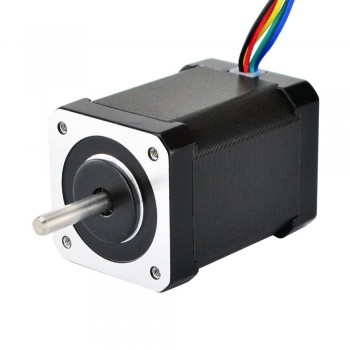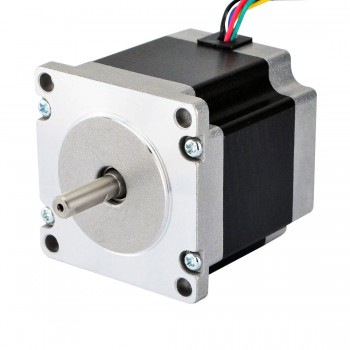Minnie's blog
1.Working principle of unipolar stepper motors
The working principle of unipolar stepper motors is to realize the rotation of the motor by controlling the order of energizing the coils on the stator. There are multiple phases on the stator. When these phases are energized in sequence, the rotor will rotate a specific angle and finally reach the required position. This working mode enables the stepper motor to obtain the exact angular position of the shaft by simple step count calculation without sensors.

2.Working state of unipolar stepper motors
1.Static: In the static state, the rotor of the stepper motor is locked in a certain position, and a DC current (pulse frequency f=0) is passed through the motor winding, and the rotor is in a locked state. In this state, the phase current of the motor winding is the largest, and the winding is not replaced, so the motor will emit uneven heat in the connected phase (not all), which is one of the most serious heating states.
2.Steady state: Steady state includes limit steady state and non-limit steady state. In the limit steady state, the motor can reach the maximum pulse frequency fmax and the corresponding maximum rotor speed nmax under a certain load. At this time, the rotor actually rotates evenly without swinging. When the pulse frequency is higher than fmax, the rotor will lose step. In the non-limit steady state, the motor contains a stable swing (oscillation) of the rotor, which is particularly dangerous in the resonant frequency area.
3.Transition state: The transition state includes processes such as starting, deceleration and stopping, and reversing. When the frequency suddenly changes from zero to the starting frequency fq, the speed of the motor rotor accelerates from zero to the limit speed. When the control pulse is suddenly interrupted, the motor decelerates sharply from the stable synchronous state to the parking lock. When the motor reverses, the rotor suddenly changes from a stable synchronous state in one rotation direction to a stable synchronous state in the opposite direction.
3.Temperature requirements for unipolar stepper motors
1.Ambient temperature requirements: The operating ambient temperature range of unipolar stepper motors is generally -20℃ to 50℃, and the most suitable ambient temperature is about 20℃. If the ambient temperature is too high, the speed of the stepper motor will slow down, the temperature will rise, and even the motor will fail to start or be damaged; if the ambient temperature is too low, the operation of the stepper motor will be unstable, affecting the performance and life of the motor.
2.Surface temperature requirements: The surface temperature of the unipolar stepper motor should be kept within 100°C. The insulation material standard of the stepper motor is ULB grade, and the temperature resistance of the motor insulation system is within 130°C, so the surface temperature of the motor should be lower than 100°C. If the surface temperature of the motor exceeds 100°C, it may cause the motor coil to burn out, affecting the safety of the insulation system.
3.Insulation level requirements: The internal insulation level of the unipolar stepper motor is usually Class B, which means that the motor can still work normally at high temperatures, but the surface temperature should not exceed 130°C. In a high temperature environment, the temperature rise of the motor can be controlled by strengthening the heat dissipation conditions or reducing the working current of the motor to prevent damage to the insulation system.
4.Humidity requirements: The humidity requirements of the stepper motor are mainly to avoid condensation inside the motor. The humidity requirements of the stepper motor are that the relative humidity is between 20%~90%RH. If the humidity is too high, it may cause condensation inside the motor, causing rust and failure.

4.Application scope of unipolar stepper motors
1.Industrial automation: In industrial robots, automated production lines, handling robots and other equipment, unipolar stepper motors can accurately control the movement speed and direction of the robot, improve production efficiency and automation level.
2.CNC machine tools: In CNC machine tools, unipolar stepper motors are used to control the movement of tools or workbenches, and achieve high-precision processing of workpieces by accurately controlling the speed and direction of the motor.
3.Printers: In inkjet printers and laser printers, unipolar stepper motors are used to control the movement of the print head, and achieve high-quality text and image printing by accurately controlling the movement of the motor.
4.Medical equipment: In medical imaging equipment such as X-ray machines, CT scanners, etc., unipolar stepper motors are used to drive the movement of the scanning frame to achieve fast and accurate imaging.
5.Aerospace: In satellite attitude control, rocket propulsion systems and other equipment, unipolar stepper motors are used to control the movement of actuators, showing good performance and high stability.
6.Entertainment and gaming equipment: In laser engraving machines, 3D printers, game controllers and other equipment, unipolar stepper motors are used to control the movement of actuators, achieving high-quality products and good user experience.
7.Education and research: In laboratory instruments, teaching equipment and other scenarios, unipolar stepper motors are used to control the movement of experimental platforms, becoming ideal teaching tools.
